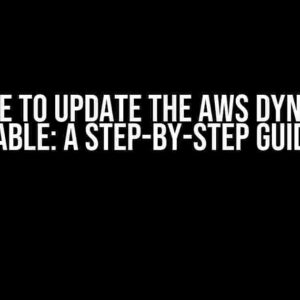Are you tired of slow database performance holding back your application’s potential? Look no further than Amazon Web Services’ (AWS) ElastiCache, a robust in-memory data store that accelerates your database’s performance by caching frequently accessed data. But, have you ever wondered how Elastic Cache cluster connectivity works in AWS? Buckle up, folks, as we dive into the fascinating world of ElastiCache and explore the inner workings of its cluster connectivity!
What is ElastiCache?
ElastiCache is a fully managed caching service offered by AWS that makes it easy to set up, manage, and scale an in-memory data store for your application. By caching frequently accessed data, ElastiCache reduces the load on your database, improving performance and reducing latency. It supports popular caching engines like Memcached and Redis, making it a versatile solution for various use cases.
How does ElastiCache Cluster Connectivity Work?
To understand how ElastiCache cluster connectivity works, let’s break it down into its key components:
Elasticache Nodes
An ElastiCache cluster consists of multiple nodes that work together to provide a highly available and scalable caching solution. Each node is a virtual machine (VM) that runs the caching engine, such as Memcached or Redis. These nodes are responsible for storing and retrieving cached data.
Elasticache Cluster
A cluster is a collection of ElastiCache nodes that are grouped together to provide a single caching solution. A cluster can consist of one or more nodes, depending on the requirements of your application.
Node Connectivity
Nodes within a cluster communicate with each other using a messaging protocol. This protocol enables nodes to exchange data and coordinate with each other to ensure that the cache remains consistent across the cluster.
Cache Replication
To ensure high availability and redundancy, ElastiCache nodes replicate data across the cluster. When a node receives a write request, it replicates the data to other nodes in the cluster, ensuring that the cache remains consistent even in the event of node failures.
How to Set Up ElastiCache Cluster Connectivity in AWS
Setting up ElastiCache cluster connectivity in AWS involves a few simple steps:
-
Log in to the AWS Management Console and navigate to the ElastiCache dashboard.
-
Create an ElastiCache cluster by selecting the desired engine (Memcached or Redis) and node type.
-
Configure the node settings, including the instance type, number of nodes, and security group.
-
Launch the cluster and wait for the nodes to become available.
-
Connect to the cluster using the ElastiCache endpoint, which is provided in the AWS Management Console.
Best Practices for ElastiCache Cluster Connectivity
To get the most out of your ElastiCache cluster, follow these best practices:
-
Use a high-availability configuration, such as a multi-AZ deployment, to ensure that your cache remains available even in the event of node failures.
-
Implement a backup and restore strategy to ensure that your cache remains up-to-date and consistent.
-
Monitor your ElastiCache cluster using Amazon CloudWatch and AWS X-Ray to identify performance bottlenecks and optimize your caching strategy.
-
Use security groups and IAM roles to control access to your ElastiCache cluster and ensure that only authorized users can access the cache.
Troubleshooting ElastiCache Cluster Connectivity Issues
Encounter issues with your ElastiCache cluster connectivity? Don’t worry, we’ve got you covered! Here are some common issues and their solutions:
| Issue | Solution |
|---|---|
| Nodes are not communicating with each other | Check the security group settings and ensure that the nodes can communicate with each other. |
| Data is not being replicated across the cluster | Verify that the replication settings are configured correctly, and check the node logs for any errors. |
| The ElastiCache endpoint is not responding | Check the ElastiCache cluster status and ensure that the nodes are available. Also, verify that the endpoint is correctly configured. |
Conclusion
In conclusion, ElastiCache cluster connectivity is a powerful tool for accelerating your database performance and improving application responsiveness. By understanding how ElastiCache cluster connectivity works and following best practices, you can unlock the full potential of your caching solution and take your application to the next level. So, what are you waiting for? Get started with ElastiCache today and experience the benefits of a high-performance caching solution!
// Sample ElastiCache configuration in AWS CLI
aws elasticache create-cache-cluster \
--cache-cluster-id my-cluster \
--engine redis \
--node-type cache.t2.micro \
--num-cache-nodes 2 \
--security-group-ids sg-12345678
Happy caching!
Frequently Asked Question
Elastic cache is a fascinating feature in AWS that can supercharge your application performance. But, have you ever wondered how it works its magic? Let’s dive into the world of Elastic cache cluster connectivity and uncover the secrets!
Q1: What is the primary purpose of an Elastic Cache cluster?
The primary purpose of an Elastic Cache cluster is to improve the performance and scalability of your application by reducing the load on your database. It achieves this by caching frequently accessed data in RAM, making it immensely faster to retrieve and update.
Q2: How does an Elastic Cache cluster handle connections?
An Elastic Cache cluster handles connections through a mechanism called “cache nodes”. These nodes are the individual servers that store the cached data. When you connect to an Elastic Cache cluster, your application is directed to one of these cache nodes, which then serves the cached data.
Q3: What is the role of the cache cluster’s configuration endpoint?
The configuration endpoint is the entry point for your application to connect to the Elastic Cache cluster. It provides information about the cluster, such as the list of available cache nodes, and directs your application to the appropriate node based on the configuration and load balancing rules.
Q4: How does Elastic Cache handle failovers and node failures?
Elastic Cache is designed to handle failovers and node failures seamlessly. When a cache node fails, the cluster automatically detects the failure and redirects traffic to another available node. This ensures that your application remains connected and continues to function without interruption.
Q5: What are the benefits of using an Elastic Cache cluster with multiple Availability Zones?
Using an Elastic Cache cluster with multiple Availability Zones provides enhanced high availability and disaster recovery. If one Availability Zone becomes unavailable, the cluster can automatically redirect traffic to another zone, ensuring that your application remains accessible and continues to function as expected.



